Magnetic and Electronic Properties of Sr Doped Infinite-Layer NdNiO2 Supercell: A Screened Hybrid Density Functional Study
Abstract
1. Introduction
2. Results and Discussions
2.1. Structures and Stabilities
2.2. Magnetism
2.3. Electronic Structure
2.4. Charge
3. Models and Computational Details
4. Conclusions
Author Contributions
Funding
Institutional Review Board Statement
Informed Consent Statement
Data Availability Statement
Conflicts of Interest
Sample Availability
References
- Yao, C.; Ma, Y. Superconducting Materials: Challenges and Opportunities for Large-Scale Applications. iScience 2021, 24, 102541. [Google Scholar] [CrossRef] [PubMed]
- Bednorz, J.G.; Müller, K.A. Possible High Tc Superconductivity in the Ba-La-Cu-O System. Z. Phys. B 1986, 64, 189–193. [Google Scholar] [CrossRef]
- Hu, L.; Wu, C. Two-Band Model for Magnetism and Superconductivity in Nickelates. Phys. Rev. Res. 2019, 1, 032046. [Google Scholar] [CrossRef]
- Li, D.; Lee, K.; Wang, B.Y.; Osada, M.; Crossley, S.; Lee, H.R.; Cui, Y.; Hikita, Y.; Hwang, H.Y. Superconductivity in an Infinite-Layer Nickelate. Nature 2019, 572, 624–627. [Google Scholar] [CrossRef] [PubMed]
- Wilson, R.M. Superconductivity Is Found in a Nickel Oxide. Phys. Today 2019, 72, 19–21. [Google Scholar] [CrossRef]
- Zhou, T.; Gao, Y.; Wang, Z. Spin Excitations in Nickelate Superconductors. Sci. China Phys. Mech. 2020, 63, 287412. [Google Scholar] [CrossRef]
- Rościszewski, K.; Oleś, A.M. Multiband D–p Model and the Electronic Structure of Quasi-Two Dimensional Nd1-XSrxNiO2. J. Magn. Magn. Mater. 2022, 541, 168533. [Google Scholar] [CrossRef]
- Liu, Z.; Xu, C.; Cao, C.; Zhu, W.; Wang, Z.F.; Yang, J. Doping Dependence of Electronic Structure of Infinite-Layer NdNiO2. Phys. Rev. B 2021, 103, 045103. [Google Scholar] [CrossRef]
- Lechermann, F. Doping-Dependent Character and Possible Magnetic Ordering of NdNiO2. Phys. Rev. Mater. 2021, 5, 044803. [Google Scholar] [CrossRef]
- Nomura, Y.; Arita, R. Superconductivity in Infinite-Layer Nickelates. Rep. Prog. Phys. 2022, 85, 052501. [Google Scholar] [CrossRef]
- Zhou, X.; Qin, P.; Feng, Z.; Yan, H.; Wang, X.; Chen, H.; Meng, Z.; Liu, Z. Experimental Progress on the Emergent Infinite-Layer Ni-Based Superconductors. Mater. Today 2022, 55, 170–185. [Google Scholar] [CrossRef]
- Si, L.; Xiao, W.; Kaufmann, J.; Tomczak, J.M.; Lu, Y.; Zhong, Z.; Held, K. Topotactic Hydrogen in Nickelate Superconductors and Akin Infinite-Layer Oxides ABO2. Phys. Rev. Lett. 2020, 124, 166402. [Google Scholar] [CrossRef]
- Salke, N.P.; Davari Esfahani, M.M.; Zhang, Y.; Kruglov, I.A.; Zhou, J.; Wang, Y.; Greenberg, E.; Prakapenka, V.B.; Liu, J.; Oganov, A.R.; et al. Synthesis of Clathrate Cerium Superhydride CeH9 at 80–100 GPa with Atomic Hydrogen Sublattice. Nat. Commun. 2019, 10, 4453. [Google Scholar] [CrossRef]
- Botana, A.S.; Norman, M.R. Similarities and Differences between LaNiO2 and CaCuO2 and Implications for Superconductivity. Phys. Rev. X 2020, 10, 011024. [Google Scholar] [CrossRef]
- Werner, P.; Hoshino, S. Nickelate Superconductors: Multiorbital Nature and Spin Freezing. Phys. Rev. B 2020, 101, 041104. [Google Scholar] [CrossRef]
- Sawatzky, G.A. Superconductivity Seen in a Non-Magnetic Nickel Oxide. Nature 2019, 572, 592–593. [Google Scholar] [CrossRef]
- Hirayama, M.; Tadano, T.; Nomura, Y.; Arita, R. Materials Design of Dynamically Stable d9 Layered Nickelates. Phys. Rev. B 2020, 101, 075107. [Google Scholar] [CrossRef]
- Mizuguchi, Y.; Fujihisa, H.; Gotoh, Y.; Suzuki, K.; Usui, H.; Kuroki, K.; Demura, S.; Takano, Y.; Izawa, H.; Miura, O. BiS2-Based Layered Superconductor Bi4O4S3. Phys. Rev. B 2012, 86, 220510. [Google Scholar] [CrossRef]
- Kamihara, Y.; Watanabe, T.; Hirano, M.; Hosono, H. Iron-Based Layered Superconductor La[O1−XFx]FeAs (X = 0.05 − 0.12) with Tc = 26 K. J. Am. Chem. Soc. 2008, 130, 3296–3297. [Google Scholar] [CrossRef]
- Nomura, Y.; Hirayama, M.; Tadano, T.; Yoshimoto, Y.; Nakamura, K.; Arita, R. Formation of a Two-Dimensional Single-Component Correlated Electron System and Band Engineering in the Nickelate Superconductor NdNiO2. Phys. Rev. B 2019, 100, 205138. [Google Scholar] [CrossRef]
- Bernardini, F.; Olevano, V.; Cano, A. Magnetic Penetration Depth and Tc in Superconducting Nickelates. Phys. Rev. Res. 2020, 2, 013219. [Google Scholar] [CrossRef]
- El-Moudny, S.; Lmouchter, M.; Zidouh, H. Electronic Structure of NdNiO2 Superconductor from Ab Initio Density-Functional-Theory Calculations. Comput. Mater. Sci. 2023, 221, 112082. [Google Scholar] [CrossRef]
- Li, Q.; He, C.; Si, J.; Zhu, X.; Zhang, Y.; Wen, H.-H. Absence of Superconductivity in Bulk Nd1−xSrxNiO2. Commun. Mater. 2020, 1, 16. [Google Scholar] [CrossRef]
- Malyi, O.I.; Varignon, J.; Zunger, A. Bulk NdNiO2 Is Thermodynamically Unstable with Respect to Decomposition While Hydrogenation Reduces the Instability and Transforms It from Metal to Insulator. Phys. Rev. B 2022, 105, 014106. [Google Scholar] [CrossRef]
- Ginzburg, V.L. Ferromagnetic Superconductors. Sov. Phys. JETP 1957, 4, 153. [Google Scholar]
- LeClair, P.; Moodera, J.S.; Philip, J.; Heiman, D. Coexistence of Ferromagnetism and Superconductivity in Ni/Bi Bilayers. Phys. Rev. Lett. 2005, 94, 037006. [Google Scholar] [CrossRef]
- Silva, B.; Luccas, R.F.; Nemes, N.M.; Hanko, J.; Osorio, M.R.; Kulkarni, P.; Mompean, F.; García-Hernández, M.; Ramos, M.A.; Vieira, S.; et al. Superconductivity and Magnetism on Flux-Grown Single Crystals of NiBi3. Phys. Rev. B 2013, 88, 184508. [Google Scholar] [CrossRef]
- Ishikado, M.; Shamoto, S.-I.; Kodama, K.; Kajimoto, R.; Nakamura, M.; Hong, T.; Mutka, H. High-Energy Spin Fluctuation in Low-Tc Iron-Based Superconductor LaFePO0.9. Sci. Rep. 2018, 8, 16343. [Google Scholar] [CrossRef]
- Liu, Z.; Ren, Z.; Zhu, W.; Wang, Z.; Yang, J. Electronic and Magnetic Structure of Infinite-Layer NdNiO2: Trace of Antiferromagnetic Metal. npj Quantum Mater. 2020, 5, 31. [Google Scholar] [CrossRef]
- Keimer, B.; Kivelson, S.A.; Norman, M.R.; Uchida, S.; Zaanen, J. From Quantum Matter to High-Temperature Superconductivity in Copper Oxides. Nature 2015, 518, 179–186. [Google Scholar] [CrossRef]
- Dai, P. Antiferromagnetic Order and Spin Dynamics in Iron-Based Superconductors. Rev. Mod. Phys. 2015, 87, 855–896. [Google Scholar] [CrossRef]
- Zhang, G.-M.; Yang, Y.-F.; Zhang, F.-C. Self-Doped Mott Insulator for Parent Compounds of Nickelate Superconductors. Phys. Rev. B 2020, 101, 020501. [Google Scholar] [CrossRef]
- Anderson, P.W. The Resonating Valence Bond State in La2CuO4 and Superconductivity. Science 1987, 235, 1196–1198. [Google Scholar] [CrossRef]
- Hayward, M.A.; Rosseinsky, M.J. Synthesis of the Infinite Layer Ni(I) Phase NdNiO2+x by Low Temperature Reduction of NdNiO3 with Sodium Hydride. Solid State Sci. 2003, 5, 839–850. [Google Scholar] [CrossRef]
- Ryee, S.; Yoon, H.; Kim, T.J.; Jeong, M.Y.; Han, M.J. Induced Magnetic Two-Dimensionality by Hole Doping in the Superconducting Infinite-Layer Nickelate Nd1-XSrxNiO2. Phys. Rev. B 2020, 101, 064513. [Google Scholar] [CrossRef]
- Hoshino, S.; Werner, P. Superconductivity from Emerging Magnetic Moments. Phys. Rev. Lett. 2015, 115, 247001. [Google Scholar] [CrossRef]
- Sakakibara, H.; Usui, H.; Suzuki, K.; Kotani, T.; Aoki, H.; Kuroki, K. Model Construction and a Possibility of Cupratelike Pairing in a New d9 Nickelate Superconductor (Nd,Sr)NiO2. Phys. Rev. Lett. 2020, 125, 77003. [Google Scholar] [CrossRef]
- Wu, X.; Di Sante, D.; Schwemmer, T.; Hanke, W.; Hwang, H.Y.; Raghu, S.; Thomale, R. Robust Wave Superconductivity of Infinite-Layer Nickelates. Phys. Rev. B 2020, 101, 060504. [Google Scholar] [CrossRef]
- Hepting, M.; Li, D.; Jia, C.J.; Lu, H.; Paris, E.; Tseng, Y.; Feng, X.; Osada, M.; Been, E.; Hikita, Y.; et al. Electronic Structure of the Parent Compound of Superconducting Infinite-Layer Nickelates. Nat. Mater. 2020, 19, 381–385. [Google Scholar] [CrossRef]
- Lee, K.W.; Pickett, W.E. Infinite-Layer LaNiO2: Ni1+ Is Not Cu2+. Phys. Rev. B 2004, 70, 165109. [Google Scholar] [CrossRef]
- Zhao, P.; Zhao, B.; Pan, J.; Wu, J. Superimpose Mechanism of Surface Generation Process in Grinding of Monocrystalline Silicon Using Molecular Dynamics Simulation. Mater. Sci. Semicond. Process. 2022, 147, 106684. [Google Scholar] [CrossRef]
- Zhao, P.; Zhao, B.; Pan, J.; Wu, J. Nano-Grinding Process of Single-Crystal Silicon Using Molecular Dynamics Simulation: Nano-Grinding Parameters Effect. Mater. Sci. Semicond. Process. 2022, 143, 106531. [Google Scholar] [CrossRef]
- Durgun, E.; Dag, S.; Bagci, V.M.K.; Gülseren, O.; Yildirim, T.; Ciraci, S. Systematic Study of Adsorption of Single Atoms on a Carbon Nanotube. Phys. Rev. B 2003, 67, 201401. [Google Scholar] [CrossRef]
- Baierle, R.J.; Fagan, S.B.; Mota, R.; da Silva, A.J.R.; Fazzio, A. Electronic and Structural Properties of Silicon-Doped Carbon Nanotubes. Phys. Rev. B 2001, 64, 085413. [Google Scholar] [CrossRef]
- Hayward, M.A.; Green, M.A.; Rosseinsky, M.J.; Sloan, J. Sodium Hydride as a Powerful Reducing Agent for Topotactic Oxide Deintercalation: Synthesis and Characterization of the Nickel(I) Oxide LaNiO2. J. Am. Chem. Soc. 1999, 121, 8843–8854. [Google Scholar] [CrossRef]
- Lu, H.; Rossi, M.; Nag, A.; Osada, M.; Li, D.F.; Lee, K.; Wang, B.Y.; Garcia-Fernandez, M.; Agrestini, S.; Shen, Z.X.; et al. Magnetic Excitations in Infinite-Layer Nickelates. Science 2021, 373, 213–216. [Google Scholar] [CrossRef]
- Fowlie, J.; Hadjimichael, M.; Martins, M.M.; Li, D.F.; Osada, M.; Wang, B.Y.; Lee, K.; Lee, Y.; Salman, Z.; Prokscha, T.; et al. Intrinsic Magnetism in Superconducting Infinite-Layer Nickelates. Nat. Phys. 2022, 18, 1043–1047. [Google Scholar] [CrossRef]
- Chen, C.; Ma, R.; Sui, X.; Liang, Y.; Huang, B.; Ma, T. Antiferromagnetic Fluctuations and Dominant Dxy-Wave Pairing Symmetry in Nickelate-Based Superconductors. Phys. Rev. B 2022, 106, 195112. [Google Scholar] [CrossRef]
- Tam, C.C.; Choi, J.; Ding, X.; Agrestini, S.; Nag, A.; Wu, M.; Huang, B.; Luo, H.Q.; Gao, P.; Garcia-Fernandez, M.; et al. Charge Density Waves in Infinite-Layer NdNiO2 Nickelates. Nat. Mater. 2022, 21, 1116–1120. [Google Scholar] [CrossRef]
- Hirsch, J.E.; Marsiglio, F. Hole Superconductivity in Infinite-Layer Nickelates. Physica C 2019, 566, 1353534. [Google Scholar] [CrossRef]
- Chang, J.; Zhao, J.; Ding, Y. Hund-Heisenberg Model in Superconducting Infinite-Layer Nickelates. Eur. Phys. J. B 2020, 93, 220. [Google Scholar] [CrossRef]
- Bernardini, F.; Olevano, V.; Blase, X.; Cano, A. Infinite-Layer Fluoro-Nickelates as d9 Model Materials. J. Phys. Mater. 2020, 3, 035003. [Google Scholar] [CrossRef]
- Fournier, P. T′ and Infinite-Layer Electron-Doped Cuprates. Physica C 2015, 514, 314–338. [Google Scholar] [CrossRef]
- Kohn, W.; Sham, L.J. Self-Consistent Equations Including Exchange and Correlation Effects. Phys. Rev. 1965, 140, A1133–A1138. [Google Scholar] [CrossRef]
- Hohenberg, P.; Kohn, W. Inhomogeneous Electron Gas. Phys. Rev. 1964, 136, B864–B871. [Google Scholar] [CrossRef]
- Kresse, G.; Furthmüller, J. Efficient Iterative Schemes for Ab Initio Total-Energy Calculations Using a Plane-Wave Basis Set. Phys. Rev. B 1996, 54, 11169–11186. [Google Scholar] [CrossRef]
- Blöchl, P.E. Projector Augmented-Wave Method. Phys. Rev. B 1994, 50, 17953–17979. [Google Scholar] [CrossRef]
- Kresse, G.; Joubert, D. From Ultrasoft Pseudopotentials to the Projector Augmented-Wave Method. Phys. Rev. B 1999, 59, 1758–1775. [Google Scholar] [CrossRef]
- Perdew, J.P.; Burke, K.; Ernzerhof, M. Generalized Gradient Approximation Made Simple. Phys. Rev. Lett. 1996, 77, 3865–3868. [Google Scholar] [CrossRef]
- Wood, D.M.; Zunger, A. A New Method for Diagonalising Large Matrices. J. Phys. A Math. Gen. 1985, 18, 1343–1359. [Google Scholar] [CrossRef]
- Heyd, J.; Scuseria, G.E.; Ernzerhof, M. Hybrid Functionals Based on a Screened Coulomb Potential. J. Chem. Phys. 2003, 118, 8207–8215, Erratum in J. Chem. Phys. 2006, 124, 219906. [Google Scholar] [CrossRef]
- Gillan, M.J. Calculation of the Vacancy Formation Energy in Aluminium. J. Phys. Condens. Matter 1989, 1, 689–711. [Google Scholar] [CrossRef]
- Štich, I.; Car, R.; Parrinello, M.; Baroni, S. Conjugate Gradient Minimization of the Energy Functional: A New Method for Electronic Structure Calculation. Phys. Rev. B 1989, 39, 4997–5004. [Google Scholar] [CrossRef] [PubMed]
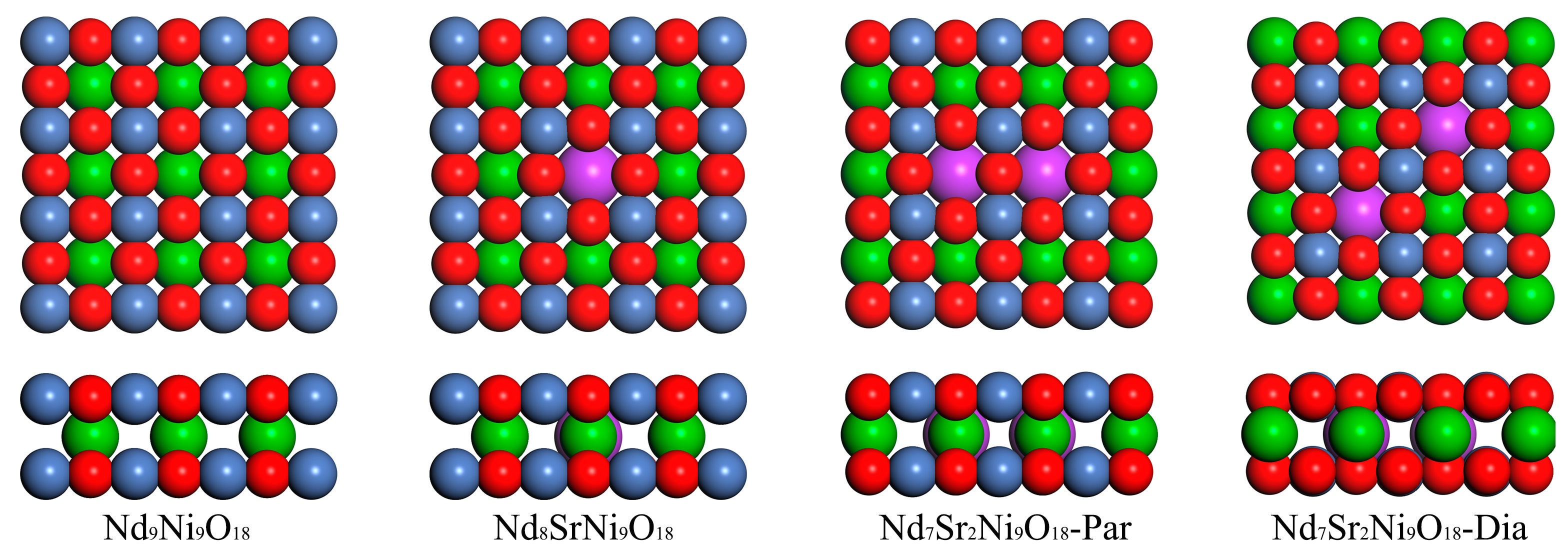
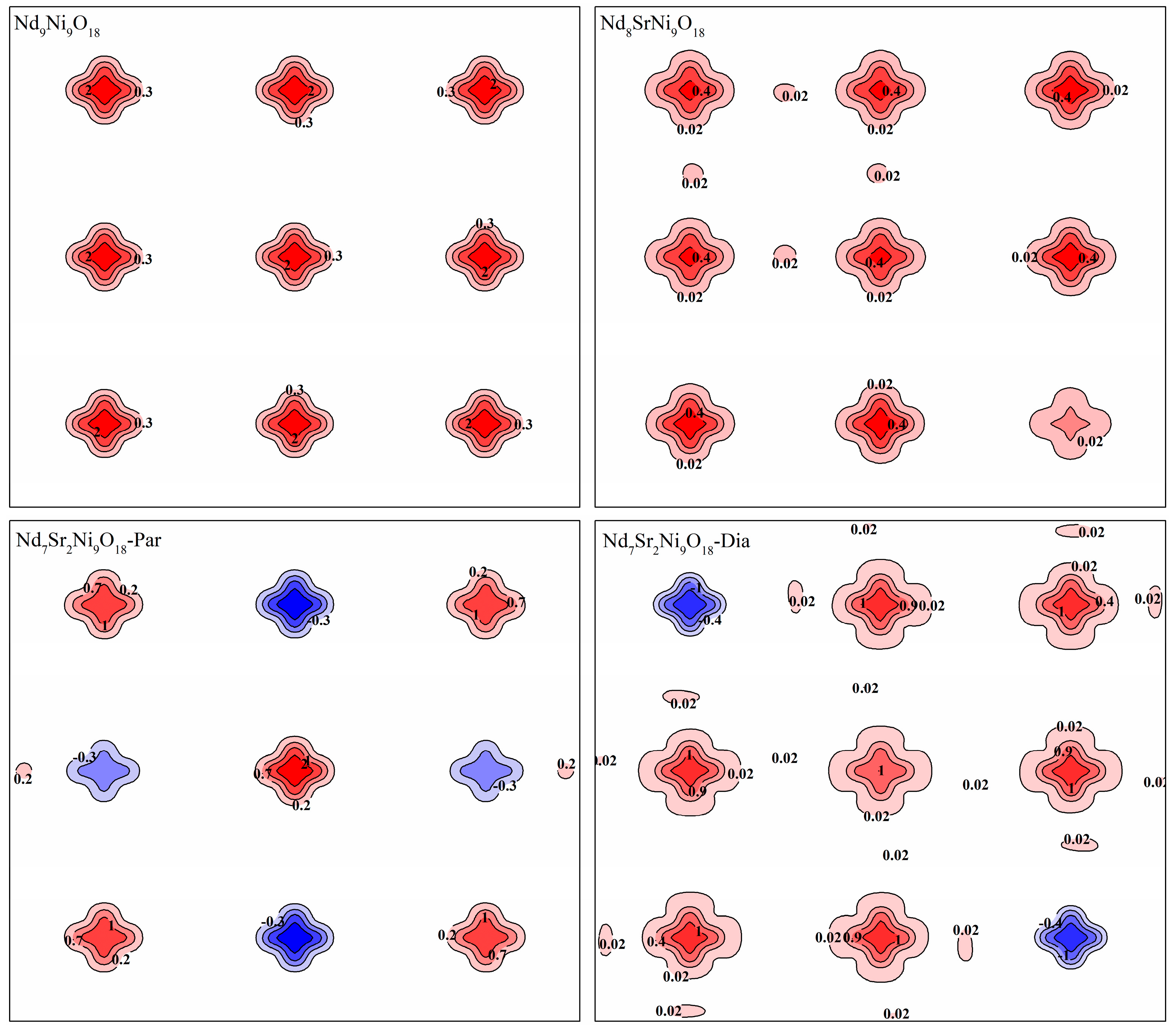
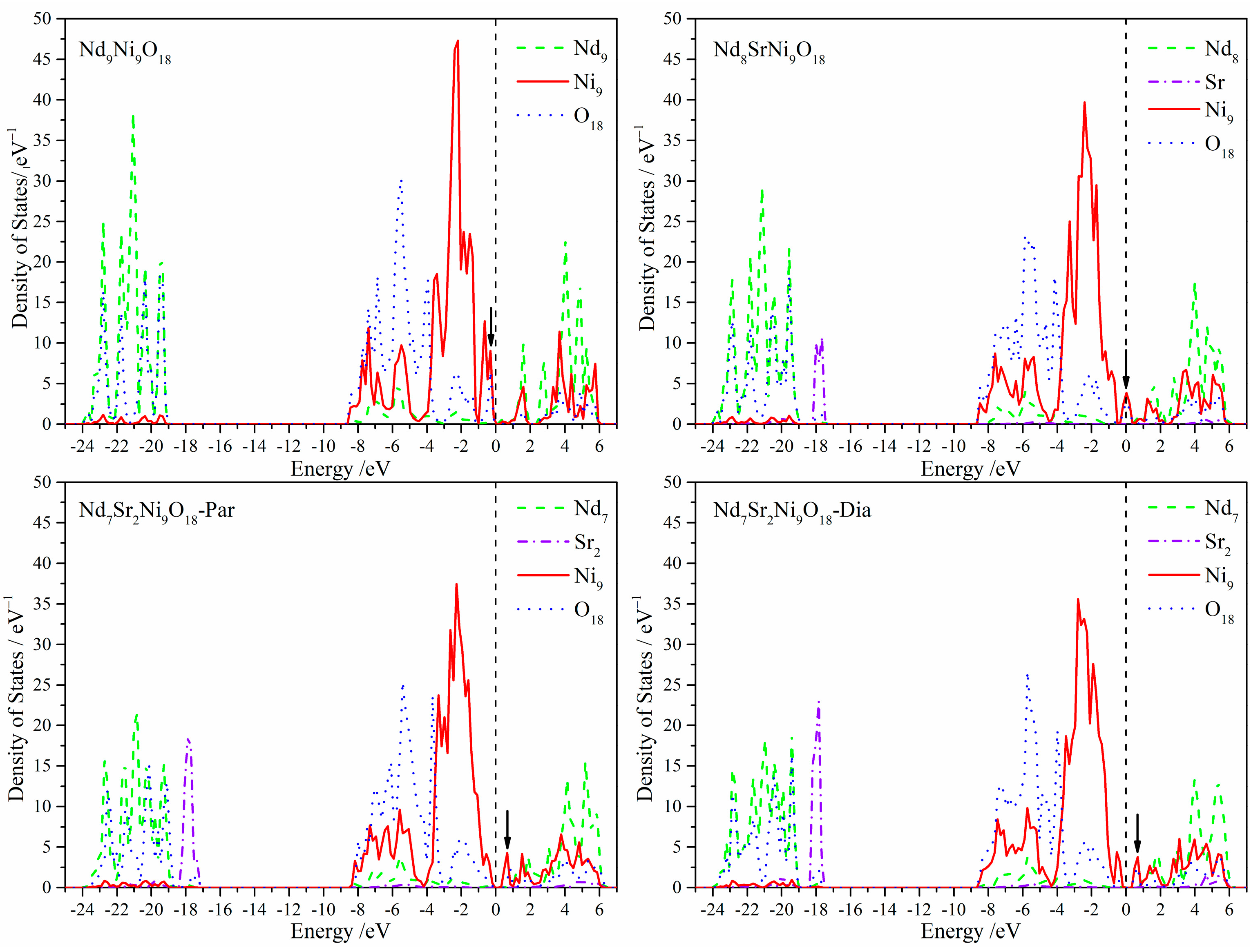
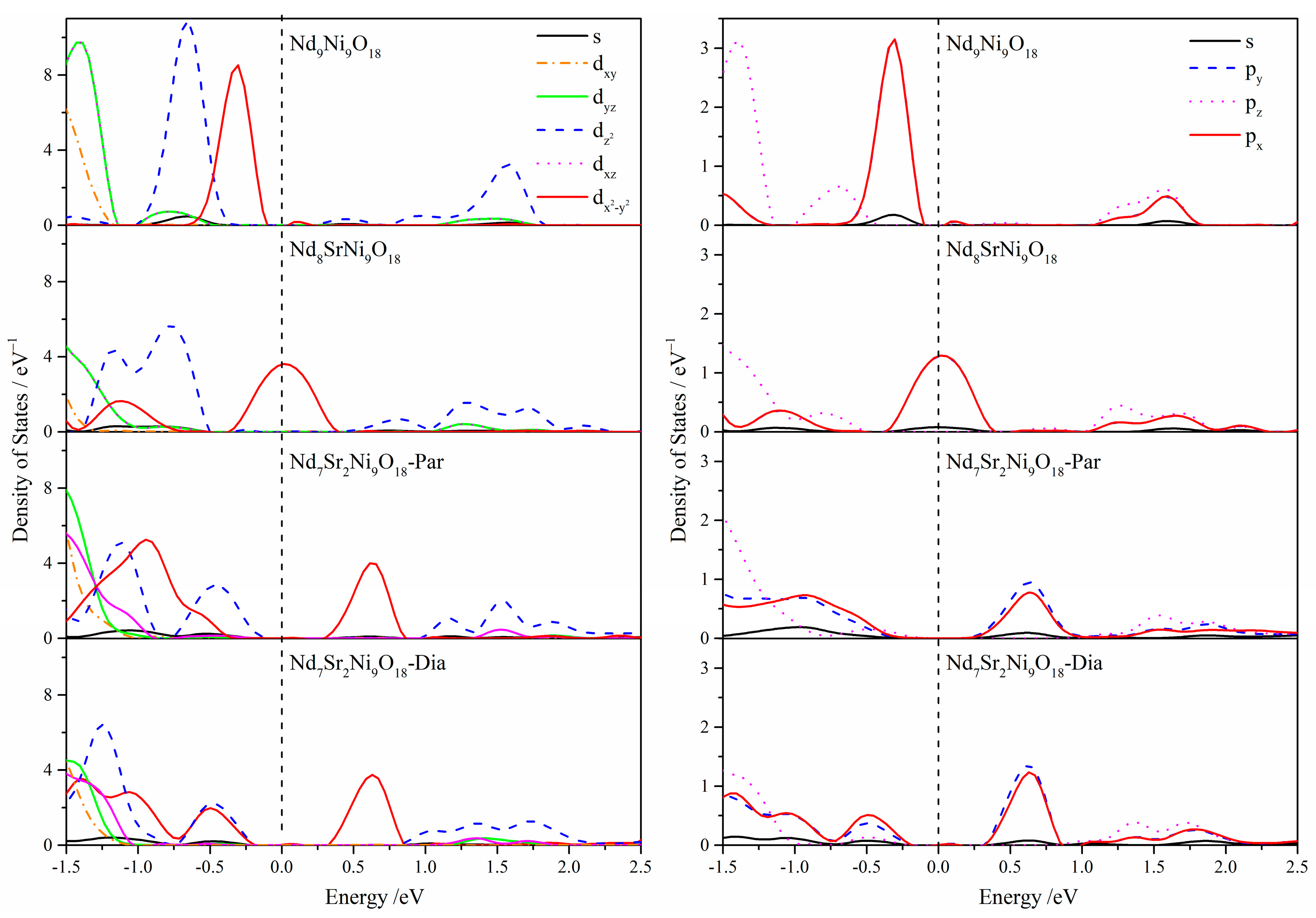
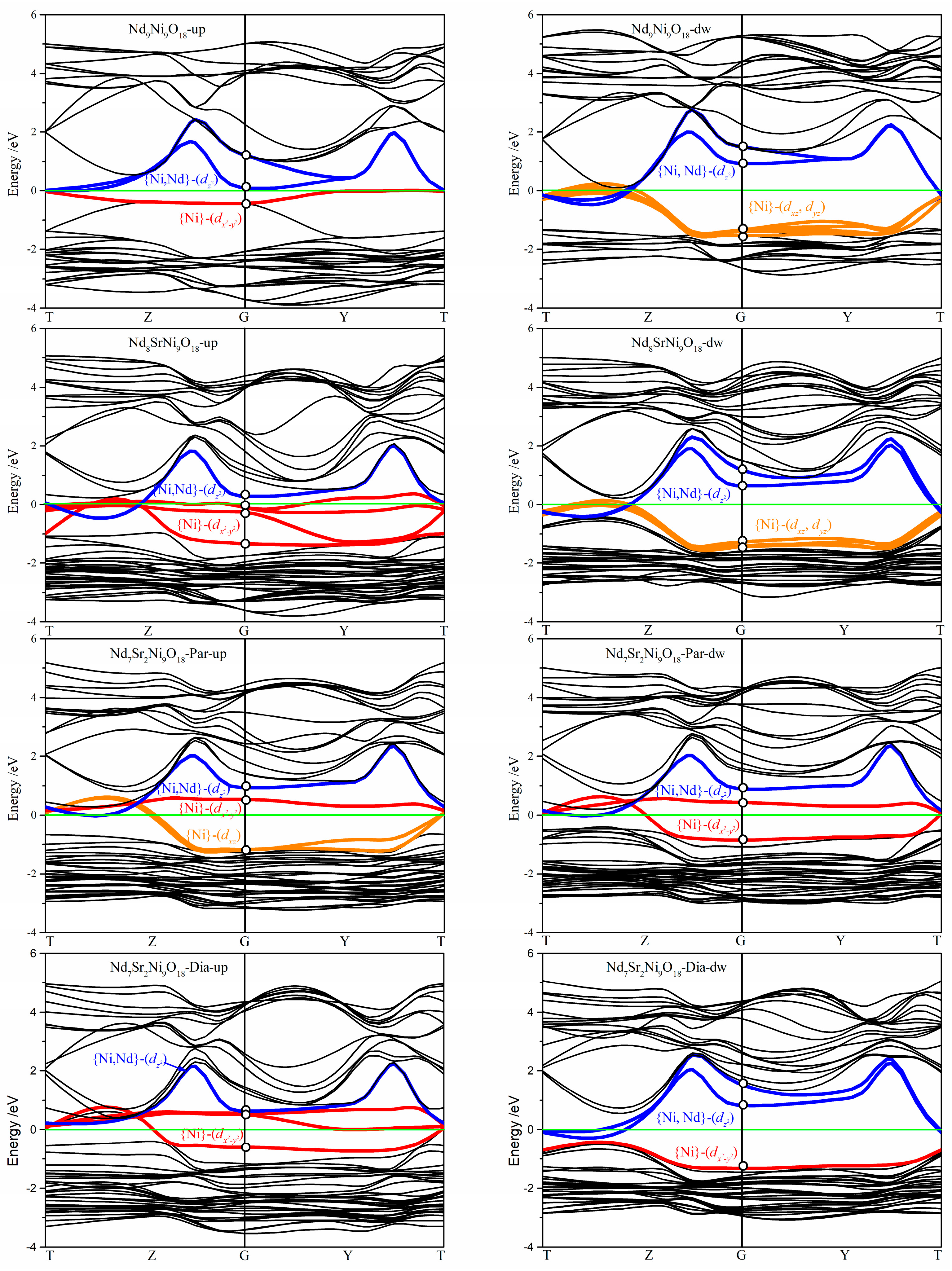
| Nd | Sr | Ni | O | |
|---|---|---|---|---|
| Nd9Ni9O18 | 8.93 (8.93, 8.93) | 9.29 (9.29, 9.29) | 7.39 (7.39, 7.39) | |
| Nd8SrNi9O18 | 8.89 (8.89, 8.90) | 8.40 (8.40, 8.40) | 9.26 (9.26, 9.29) | 7.39 (7.37, 7.40) |
| Nd7Sr2Ni9O18-Par | 9.01 (8.83, 9.14) | 8.43 (8.43, 8.43) | 9.18 (9.13, 9.20) | 7.36 (7.32, 7.39) |
| Nd7Sr2Ni9O18-Dia | 9.07 (8.87, 9.35) | 8.55 (8.55, 8.55) | 9.16 (9.08, 9.23) | 7.33 (7.31, 7.35) |
| Isolated atom | 11 | 10 | 10 | 6 |
Disclaimer/Publisher’s Note: The statements, opinions and data contained in all publications are solely those of the individual author(s) and contributor(s) and not of MDPI and/or the editor(s). MDPI and/or the editor(s) disclaim responsibility for any injury to people or property resulting from any ideas, methods, instructions or products referred to in the content. |
© 2023 by the authors. Licensee MDPI, Basel, Switzerland. This article is an open access article distributed under the terms and conditions of the Creative Commons Attribution (CC BY) license (https://creativecommons.org/licenses/by/4.0/).
Share and Cite
Hua, Y.; Wu, M.; Qin, Q.; Jiang, S.; Chen, L.; Liu, Y. Magnetic and Electronic Properties of Sr Doped Infinite-Layer NdNiO2 Supercell: A Screened Hybrid Density Functional Study. Molecules 2023, 28, 3999. https://doi.org/10.3390/molecules28103999
Hua Y, Wu M, Qin Q, Jiang S, Chen L, Liu Y. Magnetic and Electronic Properties of Sr Doped Infinite-Layer NdNiO2 Supercell: A Screened Hybrid Density Functional Study. Molecules. 2023; 28(10):3999. https://doi.org/10.3390/molecules28103999
Chicago/Turabian StyleHua, Yawen, Meidie Wu, Qin Qin, Siqi Jiang, Linlin Chen, and Yiliang Liu. 2023. "Magnetic and Electronic Properties of Sr Doped Infinite-Layer NdNiO2 Supercell: A Screened Hybrid Density Functional Study" Molecules 28, no. 10: 3999. https://doi.org/10.3390/molecules28103999
APA StyleHua, Y., Wu, M., Qin, Q., Jiang, S., Chen, L., & Liu, Y. (2023). Magnetic and Electronic Properties of Sr Doped Infinite-Layer NdNiO2 Supercell: A Screened Hybrid Density Functional Study. Molecules, 28(10), 3999. https://doi.org/10.3390/molecules28103999






